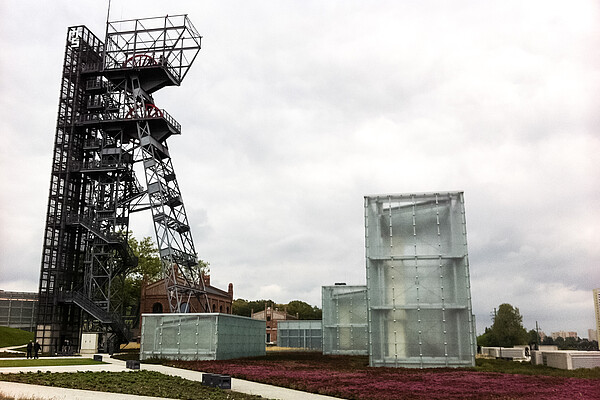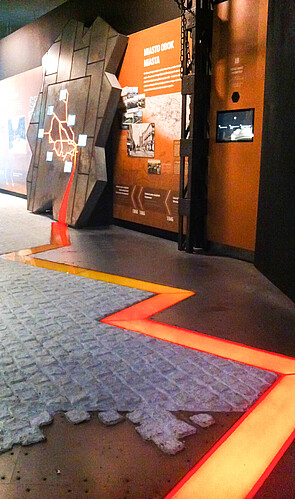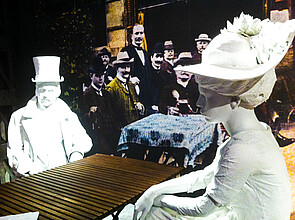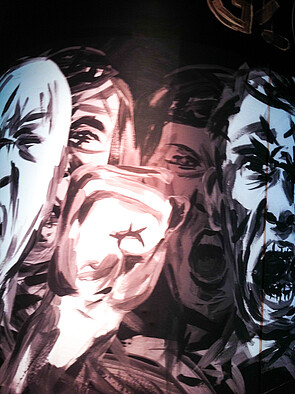01. Mar 2016 - DOI 10.25626/0048
Juliane Tomann is a post-doc research associate at the Imre Kertész Kolleg, Jena where she is responsible for the research area "History in the Public Sphere". Juliane obtained her PhD from Freie Universität Berlin with a thesis on the culture of history in times of structural change in the Upper Silesian town of Katowice since 1989. Her research interests include modern Polish history, the theory of history, applied history, public history and community-based approaches to negotiating historical representation. She has published several articles and co-edited a book on the issue of how to conceptualize applied history.

For a long time there was no comprehensive exhibition on the history and culture of Upper Silesia in Katowice, the capital of the Silesian voivodeship. The city’s original museum building from the interwar period—considered very modern at the time—was completely destroyed by the Nazis in 1941 shortly after its completion. The Silesian Museum re-opened in a former hotel in the city centre in 1984, but included no permanent historical exhibition, concentrating instead on Polish painting. The opening of the Silesian Museum’s new building in June 2015 and the permanent exhibition “Światło historii: Górny Śląsk na przestrzeni dziejów” (The light of history: Upper Silesia through the ages) has removed this deficit, presenting for the first time in Poland an extensive exhibition on the history of Upper Silesia. What appears to be the happy ending to a long and difficult history actually turns out to be a demonstration of how difficult that history really is. The turbulent background regarding the development of the exhibition offers profound insight into the continuing processes of self-discovery in a post-industrial Upper Silesia in search of its place within contemporary Poland.
Whoever enters the bright and well-lit new building of the Silesian Museum has already had to process a multitude of impressions before descending into the depths to see the exhibition. Since late June 2015, the Silesian Museum has been located in an area of the city that has only recently been developed but that now contains numerous monumental and impressive buildings. The premises of the museum on the former Katowice coal mine are part of a comprehensive urban renewal project through which the city has sought—with a so-called "axis of culture"—to create not only a new urban space, but also a post-industrial image. The museum itself is surrounded by large, imposing buildings such as the new concert hall of the Polish Radio Symphony Orchestra and a new conference centre that has walking paths on its green roof. In contrast to the other large-scale investments, however, the museum is not a completely new building, but has incorporated the former mining facility following the latter's restoration.
The architectural firm Riegler Riewe from Austria supplemented the former quarry area and mining and processing facilities with an almost transparent, square, low-rise building that, in accordance with the architecture of the former mine, has little vertical height but extends deep into the ground. In this way, a lot of space has been created on four subterranean floors that now house the new historical exhibition as well as the old permanent exhibitions of the Silesian Museum (the large collection of Polish paintings before and after 1945). A library, seminar rooms, a well-equipped museum store and several places to eat and drink surround the exhibitions, upgrading the premises and making it into an attractive new destination in the city centre for both Katowice residents and tourists. The reserved white interior design (at times almost clinically sterile), which guides visitors through the expansive space with modern pictograms, contrasts starkly with the authentic location of the coal mine. Thus, museum visitors descend into the exhibition space through what seems to be an enormous white chasm.
The beginning of the permanent exhibition, however, pulls visitors back into concrete historical reality: the recreated entrance to the Katowice mine leading to the exhibition has been painted black and gray. An oversized video installation on the opposite wall breathes life into this dark ensemble: on the screen, miners move in the direction of the visitors and appear to be getting their tickets before their shift begins. The Solidarność posters throughout indicate that the start of this historical narrative about Upper Silesia must be around 1989. "Like a miner’s lamp illuminating the mining shaft, the light of history will guide us," the introductory text promises. The text also makes clear the claims of this first overview of Upper Silesian history in the region: it intends no less than to show how the "unique identity of the region" developed.
In the second room, this courageous and tangible prelude is retracted in terms of dramaturgy and substance. The narrative takes a huge temporal leap backwards from 1989 to the medieval dynasties of the Premyslids and Piasts. The depiction is now less urgent, operating in a calmer and more distanced manner. There is a model of the Romanesque Saint Nicholas Rotunda Church in Teschen/Cieszyń in light, pleasant colours. A simulated library invites visitors to read about the most important dates and events of the period prior to 1700. The high wall shelves, however, are not filled with books; instead touchscreens have been installed in the shape of encyclopaedias. Although the transfigured touchscreens look a little strange at first glance, they do fulfil a concrete purpose: they facilitate navigating the various languages, as exhibition texts are consistently offered in Polish, German and English. The Upper Silesian regional dialect has also been included, although not in written form; visitors can listen to an audio version of most of the texts in Upper Silesian. This is an understandable decision, as Upper Silesian is not a standardized written language and varies according to location.
The tendency to use multimedia elements is already apparent in these first two rooms, and in several places, it proves to have been well thought out and sensibly implemented. Discrepancies in the ways in which information is presented, however, are visible in the second room. From this point on, a relatively old-fashioned looking timeline accompanies visitors along the exhibition wall, identifying in chronological order the most important events of the region. At this point, the encyclopaedic claims of the exhibition and the intention of including as many details as possible about developments in the region are already clear.
The design of next room suggests a palace from the early modern period. On a screen the hosts—a large aristocratic family—observe the visitors in a reserved, but friendly manner: the men with a twinkle in their eyes and the ladies fanning the air. However pleasant this greeting might be, it remains unclear what historical information these aristocrats projected on the wall are supposed to provide. Visitors are left to make their own associations, as no title or context of any kind has been provided; it is not even clear who these people are. This raises the question of the role that these aristocrats assume within the overall narrative of the exhibition, or to put this more sharply, what this narrative would lack without these playful details. In the neighbouring exhibition pieces, this tendency toward technical gimmicks continues: hanging ploughs and other agricultural implements are displayed behind a glass wall and illuminated in such a way that they appear to be flying directly at museum visitors. The rapid interplay of light and dark and the distance of the glass wall make it extremely difficult to even recognize what the objects are. The real problem of this room, however, is neither the dramatic special effects nor the technological embedding of objects: in the middle of the room there is a small model of a steam engine. Although it looks inconspicuous, the model marks the lines of conflict that arose during preparations for the exhibition. In the original conception of the exhibition from 2012, a life-sized model of a steam engine was supposed to constitute the beginning of the exhibition. According to the plans of then director Leszek Jodliński, industrialization was the decisive turning point in the history of modern Upper Silesia: industrialization formed the basis for all the developments that have influenced the region up to the present day. In this respect, Jodliński’s conception broke decisively with narrative conventions predominant in Poland about Upper Silesia, according to which the medieval dynasty of the Polish Piasts constituted the starting point for developments in the region. The conception of Upper Silesian history proposed by Jodliński led to lengthy debates, all the way up to the Silesian Regional Assembly. The stumbling block here was whether an emphasis on industrialization would open the gateway for a pro-German interpretation of the Upper Silesian past. The question about the identity of Upper Silesia as a region—which as a cultural borderland had been marked by German, Polish and regional Upper Silesian influences—was still explosive enough for the museum director to be fired and the exhibition concept to be fundamentally revised in 2013.
Despite the dichotomies, this room serves as a kind of intellectual and acoustic breather before the narrative density, details, and visual and audio-visual dramatic effects of the exhibition increase. The return to dark colours and the acoustic presence of an industrial facility are supposed to signal the upheaval ushering in a new world and a changed reality. Elaborate efforts have been made to depict the issues of industrialization, urban growth, and an altered landscape. For example, a red stream appears to shoot out of a furnace and across the floor, illuminating a map of Upper Silesian cities on the opposite wall. Next to this, the bourgeoisie, in the form of white puppets, sit in a cafe and ceremoniously invite visitors to sit down to a “Viennese coffee” that has just been ordered in German through a speaker-microphone. The lively background noise of the cafe competes here with the sounds from the industrial facility next door. It remains an open question whether the empty chairs in the cafe are supposed to encourage people to sit down to digest the flood of audio-visual information, or whether these are in fact exhibition pieces that are not supposed to be touched. Visitors must ask themselves this kind of question at other points in the exhibition as well, since clearly identifiable rules have not been provided. Is this perhaps an ambiguous call for visitor participation in an exhibition in which visitors are rarely encouraged to take part, whether in a physical or mental sense?
The central themes highlighted in the next room are the urban building boom and the development of working-class and patronage settlements around industrial plants, mines, and metallurgical works as well as the "lighter and darker sides of life in Prussia." Despite the focus on changes in everyday life, the narration remains on a superordinate level, focusing on progress through industrial development. Working conditions in factories and mines and the hardships of this very specific kind of labour have not been included here. Instead, there is information about major historical figures, for example, Bismarck and his significance for the history of the region. This is depicted metaphorically through a colourfully illuminated wall with a multitude of small Bismarck likenesses. From this perspective, Bismarck watches over the room while at the same time, the depiction maintains an ironic distance. The playfulness with the colourful Bismarck likenesses stands in contrast to the significance that Bismarck's Kulturkampf against the Catholic Church held for the region in the late nineteenth century. The room also focuses on the burgeoning national antagonisms between Germany and Poland as well as the local Upper Silesian population which cannot be classified according to national categories. The narrative here is presented on panels depicting reproductions of documents, photographs, maps, and drawings. Physical objects are scarce, and where they are present, they tend to be insignificant: for example, a white cot in the middle of the room has no evident relation to the issues addressed and seems out of place in this constellation.
Through the Kulturkampf, the issue of religion is introduced into the narrative. It is not, however, incorporated into the linear narration, but instead depicted through a kind of spatial parenthetical in the form of a prayer room. The walls of this small prayer room are covered with plastic imitations of opened Polish prayer books, and Polish-language prayers can be heard in continuous loop. This is apparently supposed to underscore to the significance of the Catholic Church in the identity of Polish-speaking Upper Silesians. However, the message of the small chapel wallpapered with prayer books remains incomprehensible. Beyond this spatial parenthetical, there are also a large number of religious objects along the wall that leads visitors through the exhibition and around a curve. A multitude of well-arranged objects in this area makes it clear that religion played a central role in Upper Silesia, although this could have been better integrated into the overall narrative.
The central focus of the subsequent rooms is everyday life in Upper Silesia. Here too, however, the issue of labour remains marginal. Instead, a film shows an Upper Silesian wedding in a typical working-class settlement, while musical instruments point to the musical traditions of the region. The historical reproduction of a kitchen is interrupted in several places: on the sideboard, there is a book that again turns out to be a touchscreen; on a large screen next to the kitchen table, a culinary scene is depicted where a mother serves regional dishes (Silesian dumplings), which a family of four consumes with satisfaction. The figures are clearly contemporary actors in historical costumes. The actual exhibition piece, the kitchen table, invites visitors to sit down and watch the film.
The chronology now arrives at the First World War, and visitors notice at least from the uneven ground that this was a tumultuous period: "The collapse of the old world," states one caption; torn and burned maps hang from the ceiling. The period after the First World War when Upper Silesia became the focus of international attention due the conflict between Poland and Germany about the region’s national affiliation, the armed uprisings, and the plebiscite, is depicted in very little space and with great dramatic effect. The clearest example of this is how German and Polish election propaganda prior to the plebiscite in 1921 is portrayed. The tense political situation is represented by two rotating advertising columns with screaming black-and-white faces through which visitors have to pass in order to enter a black room with flashy, aggressive posters of the competing German and Polish sides.
The beginning of the period in which Upper Silesia was divided between Germany and Poland in 1922 is symbolized by two triumphal arches at the entrance to the next room: one with German and one with Polish colours and symbols. A white ray of light suddenly illuminates the floor of the exhibition, underscoring the abruptness and volatility of the border running right through the Upper Silesian urban agglomeration marked on a drawing board. The German-Polish rivalry along the new border during the interwar period is presented here particularly through architecture and urban planning. A multitude of recreated building facades facing one another on the German and Polish sides of the room test the limits of the visitor's attention span. There is a lot of remarkable architecture to discover here, for instance, the Seidenhaus Weichmann built by Erich Mendelsohn in the German town of Gleiwitz, and also the depiction of the beginnings of the Silesian Museum in Katowice during the interwar period.
With the subject of Nazi dictatorship and the Second World War, visitors are confronted with sensitive issues for Upper Silesians such as "Upper Silesians in the Wehrmacht" and the "Deutsche Volksliste", a Nazi institution that classified inhabitants according to categories systematized by Heinrich Himmler. The system of the Volksliste and the treatment of individual groups before and after 1945 is presented in detail and documented through eyewitness interviews. The issues depicted here, and in a very limited space, are the course of the war, the flight and expulsion of the Germans from the region, the "Upper Silesian tragedy," and also the identification of righteous individuals from different nationalities. The guillotine the Nazis used to execute 552 people in Nikolai Street in Katowice between 1941 and 1945 sits in the dark centre of the room. The guillotine is not entirely visible, but rather is covered by a black sarcophagus and can only be seen through a narrow observation slit at eye level. While it certainly shows courage and decisiveness to include in the exhibition an object so dubious in ethical terms, its ultimate value is questionable when it remains almost completely covered.
With the shifting of Poland’s borders westward after 1945, most of the territory of Upper Silesia became Polish. The Upper Silesian agglomeration was one of the most important industrial centres in the People’s Republic of Poland, and the exhibition depicts these developments between 1945 and 1989 in great detail. The economic and social processes are presented through the recreation of a room in a so-called working-class hotel as well as two furnished apartments in new high-rise buildings. After the war, Upper Silesia urgently needed workers who had to be recruited outside of the region and were often accommodated in working-class hotels. Surrounding the old city centre and working-class settlements from the nineteenth century, new high-rising buildings were erected to provide a home for workers and administrative officials. This part of the exhibition is evidently supposed to depict a phase of economic stability accompanied by a gradual cultural blossoming, and also the social mingling of the population on the basis of the new influx. This somewhat nostalgic perspective on the period of the People’s Republic of Poland obscures a number of sensitive issues: for example, the fact that until Stalin's death, Katowice was called Stalinogród is mentioned only in passing, as are repressive measures against Upper Silesians who were not allowed to speak their own dialect in the People’s Republic and had to adapt themselves to the Polish majority.
The narrative concludes with the dangers and uncertainties for people and for the environment caused by extensive mining and industry as well as the crises of the Polish political system in the late 1980s. With the wave of strikes in 1980–81 and the emergence of the Solidarność trade union movement, the exhibition returns to its starting point, concluding the narrative circle. It is certainly praiseworthy that the period of the People's Republic of Poland has been given so much space in the exhibition, despite the romanticized perspective. This does not, however, explain why the narrative does not continue beyond 1989. Precisely in a region such as Upper Silesia, which not only experienced structural change after 1989 but also fundamental changes through a renaissance of regional identities, the narrative simply should not end here. There are too many questions that remain open in the present for them to be ignored by an important cultural institution such as the Silesian Museum. The fact that the exhibition concludes in 1989 shows how great the curators’ reservations must have been about incorporating processes and developments of the past twenty-five years and addressing the continuing self-discovery of Upper Silesia within Poland’s democracy and market economy. What also makes this ending curious it that the final wall-text explicitly raises the question of the region’s future, expressing the hope that Upper Silesia will be characterized in the future by stable development (devoid of historical upheavals) so that the potential of the region can finally be realized in its entirety. At the end of the exhibition, visitors are once again addressed concretely, this time with the following question: "Will you participate in shaping the future of Upper Silesia?" Individual answers can be left in a multimedia guestbook that records a brief video sequence and is played on a monitor in the visitor's gallery.
In the end, a mixed impression remains. On the one hand, it is important that for the very first time in the region, the history of Upper Silesia is the subject of such a comprehensive museum exhibition. It took a long time for this to happen: although the Silesian Museum was re-established in 1984, prior to the current exhibition, there had been no permanent exhibitions providing an overview of Upper Silesian history. Even in the planning stages, the current exhibition was an object of political contention. This is clearly evident in the quarrels that emerged during the development of the exhibition, the replacement of the museum director and the revisions and adaptations of the exhibition concept. The initial claim that the exhibition would present identity-building elements of the region proved difficult to maintain. Instead, as much material as possible was presented, apparently in order to do justice to the variety of Upper Silesia as a borderland over the long period of its development. In the end, the exhibition looks like an attempt to illustrate encyclopaedic knowledge without identifying concrete statements or theses. The show initiates almost no real dialogue about history and identity, which in Upper Silesia, must always be an exchange between generations. It raises too few questions and does not offer enough substance to encourage visitors to think through the material and form their own opinions and positions. In many places, the exhibition tends in the direction of a historical theme park, which has little to do with critical historical analysis or self-reflection. For this reason, the light metaphor in the title of the exhibition remains an unfulfilled promise. Rather than well-chosen emphases and stimulating questions, visitors are confronted with a flood of information; in order to work through this, they would have to follow up their visit to the museum with further reading. An exhibition catalogue would be helpful in this regard, and one is currently in preparation.
Translated by Thomas Lampert
Juliane Tomann: “The Light of History”: The First Permanent Exhibition on Upper Silesian History in Poland Avoids Sensitive Issues and Focuses on Ostensible Consensus. In: Cultures of History Forum (01.03.2016), DOI: 10.25626/0048.
Copyright (c) 2016 by Imre Kertész Kolleg, all rights reserved. This work may be copied and redistributed for non-commercial, educational purposes, if permission is granted by the copyright holders. For permission please contact the editors.
Blog of the former director of the museum, Leszek Jodliński (in Polish)
"Spor o Muzeum Slaskie" (article from "Dziennik Zachodni", in Polish)
"Muzeum Slaskie. Nad wystawa historyczna przeszedl walec i wyrownal" (Prof. Ewa Chojecka on the new exhibition in Gazeta Wyborcza, in Polish)




Lidia Zessin-Jurek · 20.04.2023
A History that Connects and Divides: Ukrainian Refugees and Poland in the Face of Russia’s War
Read more
Lidia Zessin-Jurek · 20.12.2021
Trapped in No Man’s Land: Comparing Refugee Crises in the Past and Present
Read more
Interview · 08.03.2021
A Ruling Against Survivors – Aleksandra Gliszczyńska-Grabias about the Trial of Two Polish Holocaust...
Read more
Lidia Zessin-Jurek · 03.09.2019
Hide and Seek with History – Holocaust Teaching at Polish Schools
Read more
Maciej Czerwiński · 11.04.2019
Architecture in the Service of the Nation: The Exhibition ‘Architecture of Independence in Central E...
Read more
Get this article as PDF download (including pictures).